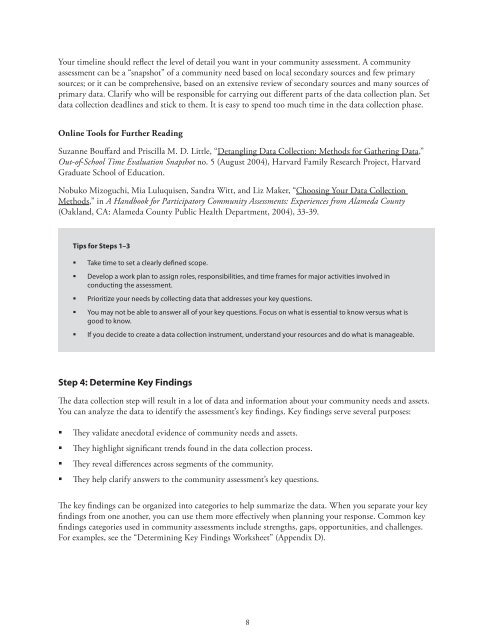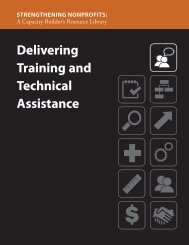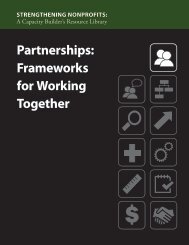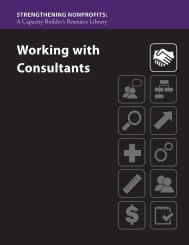Conducting a Community Assessment - Strengthening Nonprofits
Conducting a Community Assessment - Strengthening Nonprofits
Conducting a Community Assessment - Strengthening Nonprofits
You also want an ePaper? Increase the reach of your titles
YUMPU automatically turns print PDFs into web optimized ePapers that Google loves.
Your timeline should reflect the level of detail you want in your community assessment. A communityassessment can be a “snapshot” of a community need based on local secondary sources and few primarysources; or it can be comprehensive, based on an extensive review of secondary sources and many sources ofprimary data. Clarify who will be responsible for carrying out different parts of the data collection plan. Setdata collection deadlines and stick to them. It is easy to spend too much time in the data collection phase.Online Tools for Further ReadingSuzanne Bouffard and Priscilla M. D. Little, “Detangling Data Collection: Methods for Gathering Data,”Out-of-School Time Evaluation Snapshot no. 5 (August 2004), Harvard Family Research Project, HarvardGraduate School of Education.Nobuko Mizoguchi, Mia Luluquisen, Sandra Witt, and Liz Maker, “Choosing Your Data CollectionMethods,” in A Handbook for Participatory <strong>Community</strong> <strong>Assessment</strong>s: Experiences from Alameda County(Oakland, CA: Alameda County Public Health Department, 2004), 33-39.Tips for Steps 1–3• Take time to set a clearly defined scope.• Develop a work plan to assign roles, responsibilities, and time frames for major activities involved inconducting the assessment.• Prioritize your needs by collecting data that addresses your key questions.• You may not be able to answer all of your key questions. Focus on what is essential to know versus what isgood to know.• If you decide to create a data collection instrument, understand your resources and do what is manageable.Step 4: Determine Key FindingsThe data collection step will result in a lot of data and information about your community needs and assets.You can analyze the data to identify the assessment’s key findings. Key findings serve several purposes:• They validate anecdotal evidence of community needs and assets.• They highlight significant trends found in the data collection process.• They reveal differences across segments of the community.• They help clarify answers to the community assessment’s key questions.The key findings can be organized into categories to help summarize the data. When you separate your keyfindings from one another, you can use them more effectively when planning your response. Common keyfindings categories used in community assessments include strengths, gaps, opportunities, and challenges.For examples, see the “Determining Key Findings Worksheet” (Appendix D).8






